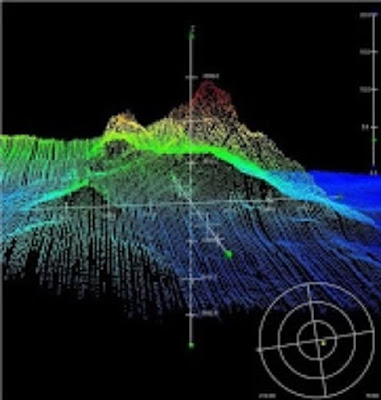
Earth’s biggest volcano, its peak nearly two kilometers beneath the Pacific Ocean waves, is beginning to reveal its secrets.
New magnetic data suggest that the gigantic underwater mountain known as Tamu Massif, 1,600 kilometers east of Japan, is a kind of volcanic hybrid—a mash-up of long chains of volcanoes and one enormous eruption. “We’re looking at something that’s in between a mid-ocean ridge and a simple conical volcano,” says William Sager, a marine geophysicist at the University of Houston. Mid-ocean ridges are where fresh lava wells up from deep inside Earth to create newborn ocean crust; they run for thousands of kilometers along the centers of most ocean basins.
Sager and his colleagues collected the new data on a five-week-long cruise that ended on November 10 onboard the R/V Falkor, a research vessel run by the Schmidt Ocean Institute of Palo Alto, Calif. The trip was the latest attempt to unravel the mysteries of this enormous volcano, and showed that its birth was more complex than scientists had suspected.
Covering an area roughly the size of New Mexico, Tamu Massif towers more than four kilometers above the seafloor. “This volcano is a beast,” says Jörg Geldmacher, a marine geophysicist at the GEOMAR Helmholtz Center for Ocean Research Kiel in Germany.
Tamu Massif’s size may trace back to the unusual circumstances of its origin. Around 145 million years ago lava began pouring out on the seafloor where three mid-ocean ridges came together in a geologic “triple junction.” Each ridge spewed out lava that cooled and preserved a record of the Earth’s magnetism at the time. Because the planet’s magnetic field has reversed direction many times over millions of years, the lava over time recorded stripes of alternating magnetic polarity on either side of the ridge where it was born.
Earlier research cruises had mapped hints of these magnetic stripes, by towing magnetic recording instruments behind ships as they sailed back and forth. But the information was spotty. Sager and Masao Nakanishi, a geophysicist at Chiba University in Japan, organized the Falkor cruise to gather the best magnetic data to date. They sailed up and back over Tamu Massif in an enormous grid covering nearly a million square kilometers.
Some 1.7 million magnetic measurements later, the scientists confirmed what they had only suspected earlier: Tamu Massif seems to have coherent magnetic stripes on either side of it, like those seen at seafloor spreading ridges. That suggests at least part of Tamu Massif was born from fresh lava welling up in orderly stripes at the geological triple junction.
The main mountain itself is more of a shapeless magnetic blob, however. That blobbiness suggests something else is also going on—perhaps a plume of hot rock rising from deep within Earth up through the mantle, fueling an eruption on the surface like a welder’s torch blasting upward. If so, then Tamu Massif is one of the few places on the planet where a mantle plume may have interacted with a triple junction, Geldmacher says.
The question is how much lava came from one as opposed to the other. “If you looked at a mid-ocean ridge and sliced it open, you’d find magma underneath,” Sager says. “How do you get a separate volcanic plumbing system at the same spot?”
The researchers still need to work through the Falkor data, but the new information should help unravel the mystery of the volcano’s birth, Nakanishi says. More broadly, Tamu Massif could help scientists better understand the volcanic phenomena that create the three fifths of Earth’s crust that lies beneath the oceans.
During the cruise, the Falkor also mapped Tamu Massif in unprecedented three-dimensional detail. Among other things it revealed a newfound small mountain off the west end. And steep cliffs at the base of Tamu Massif may represent places where it is subsiding into the seafloor or where underwater landslides occurred.
Video
Note: The above post is reprinted from materials provided by Nature. The original article was written by Scientific American.









